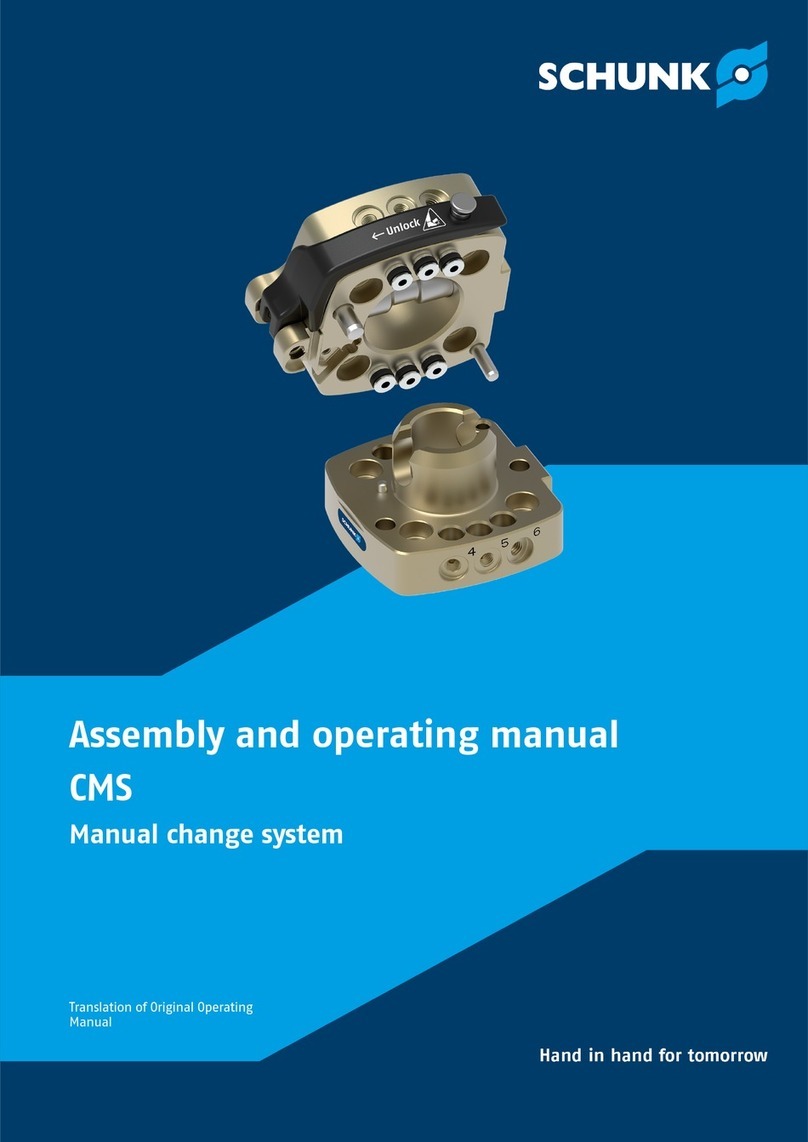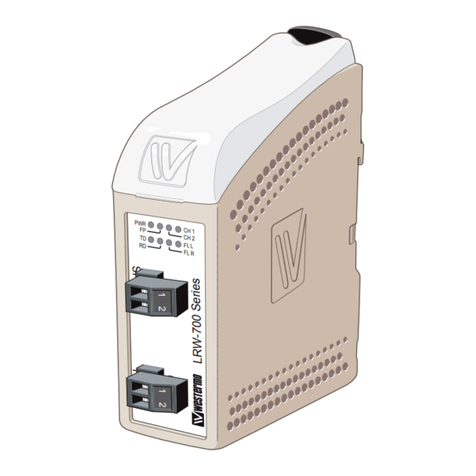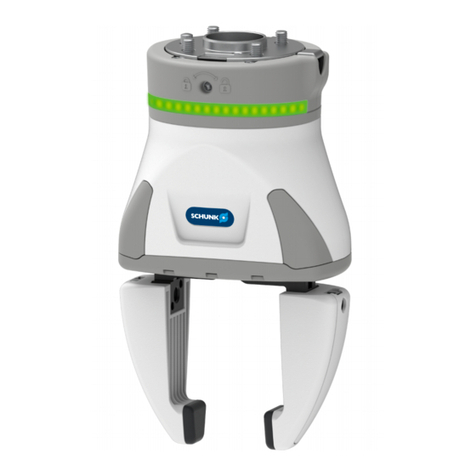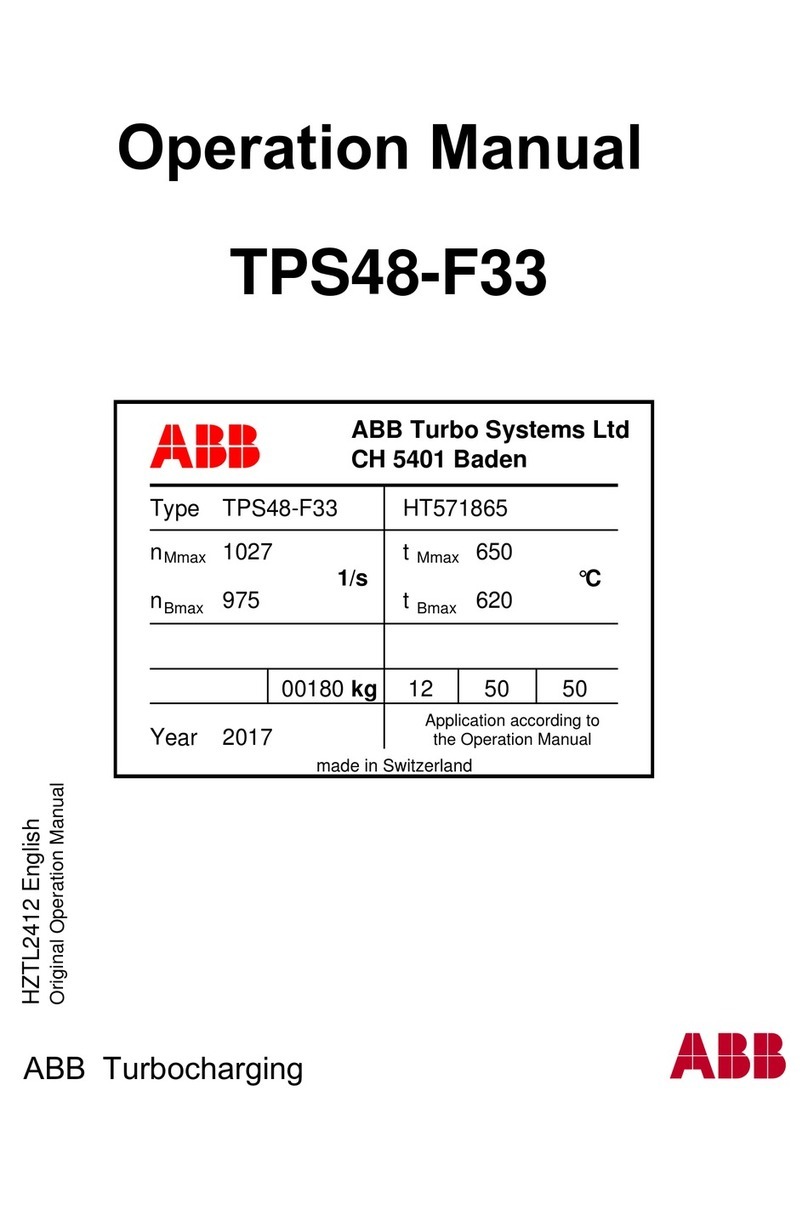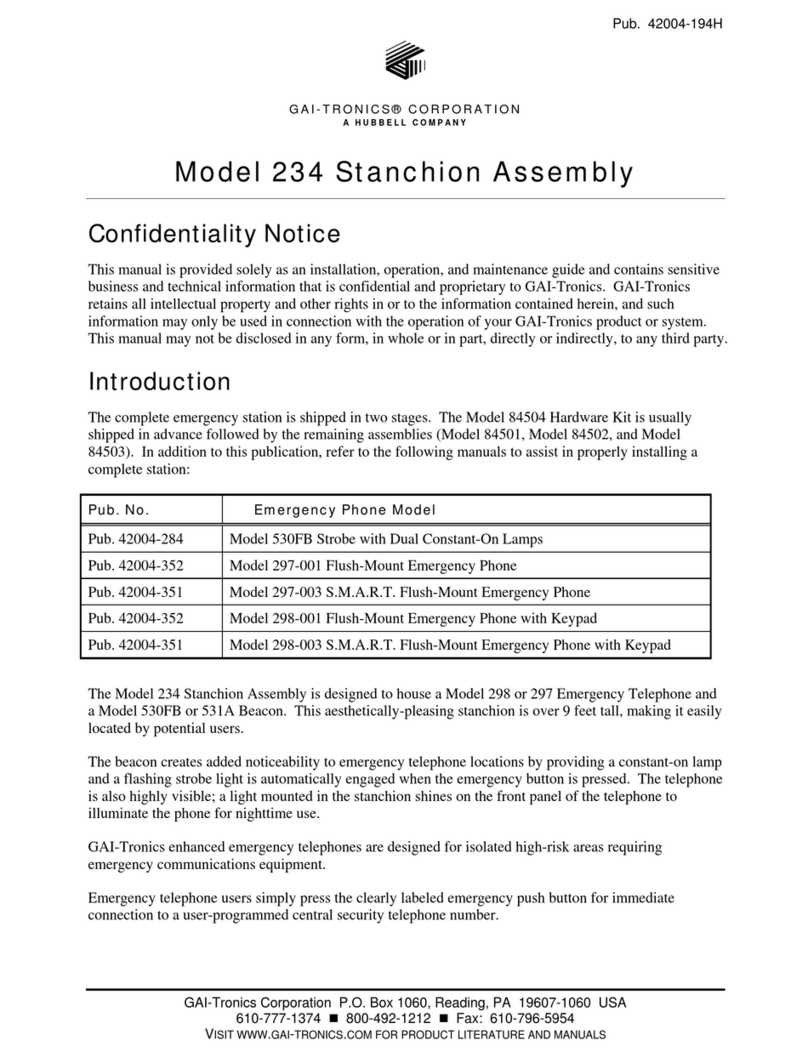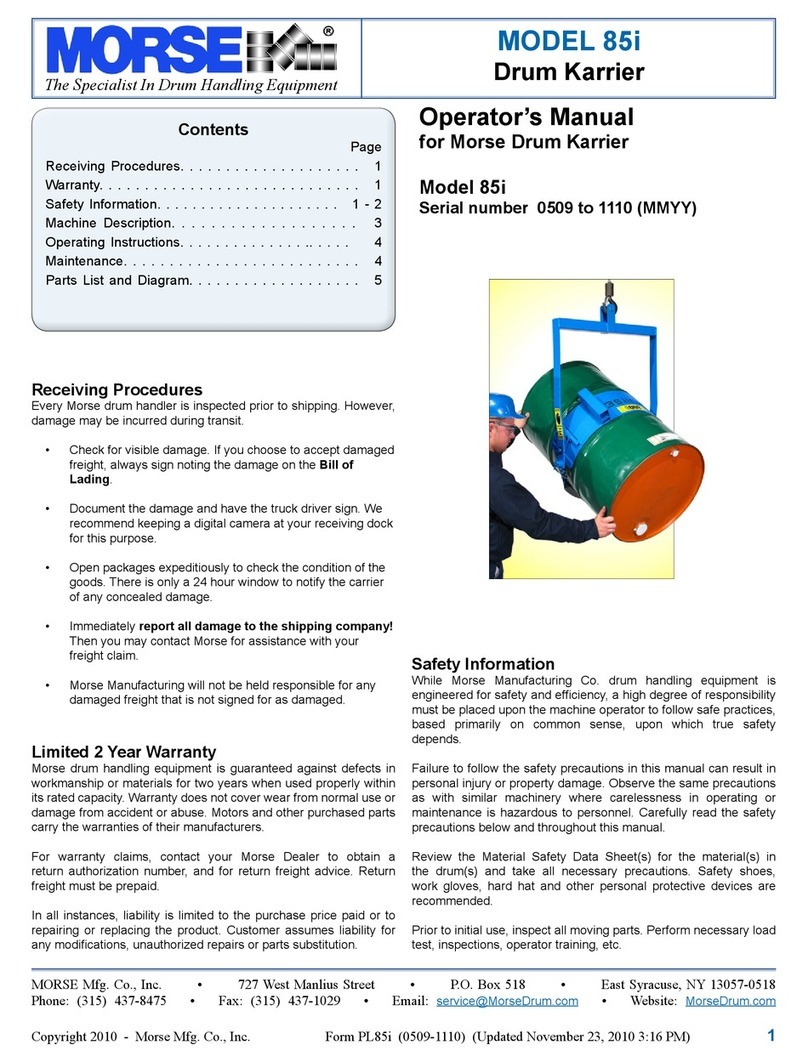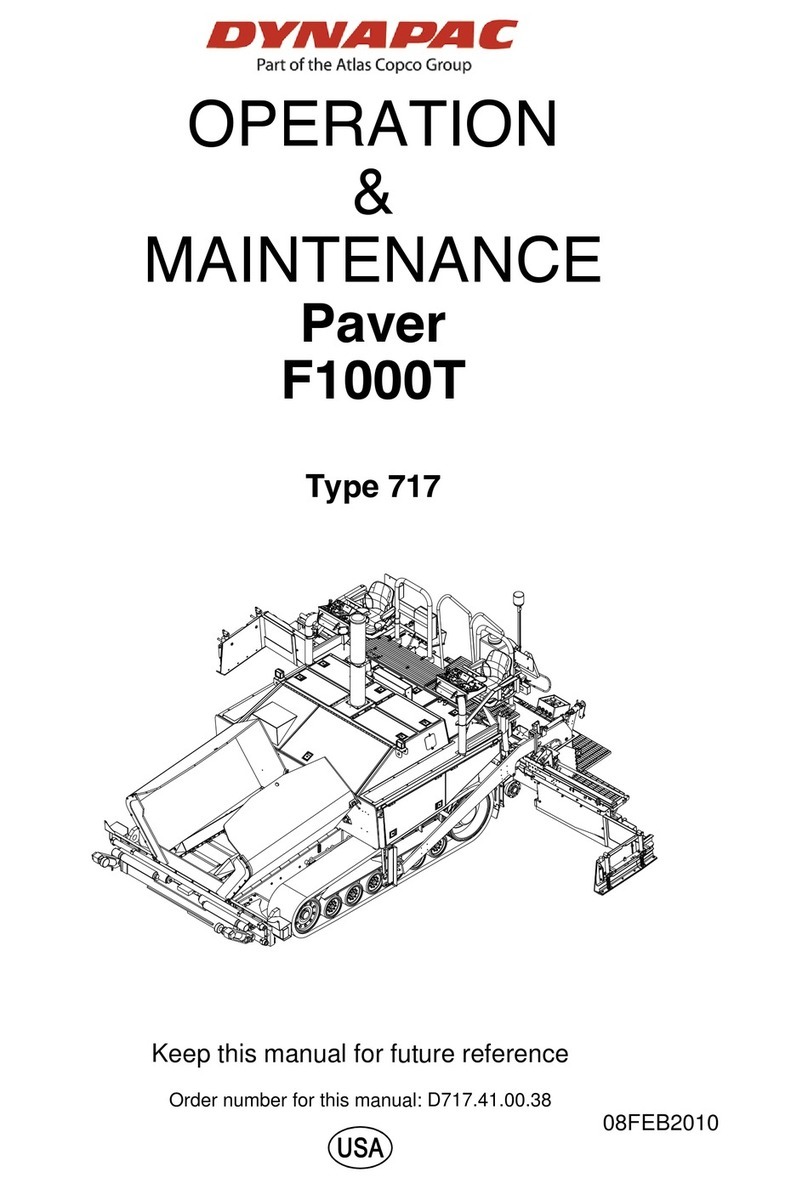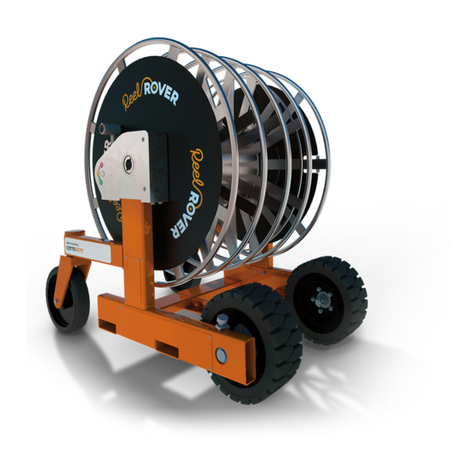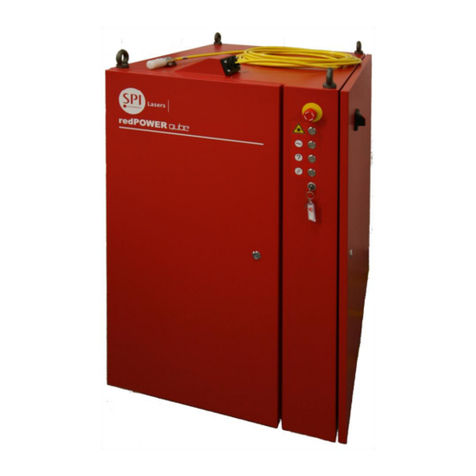CHART TRIFECTA 2K User manual

Trifecta 2K
Service Manual
OPERATING INSTRUCTIONS
TRIFECTA 2K
TRIFECTA Gas Supply System - Rev D

Trifecta 2K

Trifecta 2K
GENERAL . . . . . . . . . . . . . . . . . . . . . . . . . . . . . . . . . . . . . . . . . . . . . . . . . . . . . . . . . . . . .1
SYSTEM SPECIFICATIONS . . . . . . . . . . . . . . . . . . . . . . . . . . . . . . . . . . . . . . . . . . . . . . .1
DIMENSIONS . . . . . . . . . . . . . . . . . . . . . . . . . . . . . . . . . . . . . . . . . . . . . . . . . . . . . . . . . .1
FLOW . . . . . . . . . . . . . . . . . . . . . . . . . . . . . . . . . . . . . . . . . . . . . . . . . . . . . . . . . . . . . . .1
ELECTRICAL . . . . . . . . . . . . . . . . . . . . . . . . . . . . . . . . . . . . . . . . . . . . . . . . . . . . . . . . . .1
SAFETY . . . . . . . . . . . . . . . . . . . . . . . . . . . . . . . . . . . . . . . . . . . . . . . . . . . . . . . . . . . . .2
Safety Summary . . . . . . . . . . . . . . . . . . . . . . . . . . . . . . . . . . . . . . . . . . . . . . . . . . . .2
Safety Bulletin . . . . . . . . . . . . . . . . . . . . . . . . . . . . . . . . . . . . . . . . . . . . . . . . . . . . .3
INSTALLATION . . . . . . . . . . . . . . . . . . . . . . . . . . . . . . . . . . . . . . . . . . . . . . . . . . . . . . . . .6
PLACEMENT OF SKID . . . . . . . . . . . . . . . . . . . . . . . . . . . . . . . . . . . . . . . . . . . . . . . . . . . .6
PLUMBING TO BULK TANK . . . . . . . . . . . . . . . . . . . . . . . . . . . . . . . . . . . . . . . . . . . . . . . .6
PLUMBING TO VAPORIZER . . . . . . . . . . . . . . . . . . . . . . . . . . . . . . . . . . . . . . . . . . . . . . . .7
BULK TANK PRESSURE TRANSMITTER . . . . . . . . . . . . . . . . . . . . . . . . . . . . . . . . . . . . . . . .8
Plumbing to Bulk Tank Pressure Transmitter . . . . . . . . . . . . . . . . . . . . . . . . . . . . . .8
ELECTRICAL POWER SUPPLY . . . . . . . . . . . . . . . . . . . . . . . . . . . . . . . . . . . . . . . . . . . . . .9
COMMISSIONING . . . . . . . . . . . . . . . . . . . . . . . . . . . . . . . . . . . . . . . . . . . . . . . . . . . . . .10
Control Panel Heater . . . . . . . . . . . . . . . . . . . . . . . . . . . . . . . . . . . . . . . . . . . . . . .11
OPERATION . . . . . . . . . . . . . . . . . . . . . . . . . . . . . . . . . . . . . . . . . . . . . . . . . . . . . . . . . .12
AUTOMATIC MODE . . . . . . . . . . . . . . . . . . . . . . . . . . . . . . . . . . . . . . . . . . . . . . . . . . . .12
PLC CONTROLLER INTERFACE . . . . . . . . . . . . . . . . . . . . . . . . . . . . . . . . . . . . . . . . . . . .13
Changing Parameters . . . . . . . . . . . . . . . . . . . . . . . . . . . . . . . . . . . . . . . . . . . . . . .13
Typical Operating Cycle . . . . . . . . . . . . . . . . . . . . . . . . . . . . . . . . . . . . . . . . . .14
Fill Mode . . . . . . . . . . . . . . . . . . . . . . . . . . . . . . . . . . . . . . . . . . . . . . . . . . . . .14
MANUAL MODE . . . . . . . . . . . . . . . . . . . . . . . . . . . . . . . . . . . . . . . . . . . . . . . . . . . . . . 15
REPLACEMENT PARTS . . . . . . . . . . . . . . . . . . . . . . . . . . . . . . . . . . . . . . . . . . . . . . . . . 16
SOLENOID VALVES . . . . . . . . . . . . . . . . . . . . . . . . . . . . . . . . . . . . . . . . . . . . . . . . . . . . .17
PRESSURE/DIFFERENTIAL PRESSURE TRANSMITTERS . . . . . . . . . . . . . . . . . . . . . . . . . . . . 17
LASER-CYL PRESSURE SAFETY DEVICES . . . . . . . . . . . . . . . . . . . . . . . . . . . . . . . . . . . . .17
LINE RELIEF VALVES . . . . . . . . . . . . . . . . . . . . . . . . . . . . . . . . . . . . . . . . . . . . . . . . . . 17
FUSES . . . . . . . . . . . . . . . . . . . . . . . . . . . . . . . . . . . . . . . . . . . . . . . . . . . . . . . . . . . . . 18
RESISTOR ELEMENTS . . . . . . . . . . . . . . . . . . . . . . . . . . . . . . . . . . . . . . . . . . . . . . . . . . .18
RELAYS . . . . . . . . . . . . . . . . . . . . . . . . . . . . . . . . . . . . . . . . . . . . . . . . . . . . . . . . . . . .19
TROUBLESHOOTING . . . . . . . . . . . . . . . . . . . . . . . . . . . . . . . . . . . . . . . . . . . . . . . . . . .20
SENSOR ERROR CHECK . . . . . . . . . . . . . . . . . . . . . . . . . . . . . . . . . . . . . . . . . . . . . . . . . 20
Sensor Error Solutions . . . . . . . . . . . . . . . . . . . . . . . . . . . . . . . . . . . . . . . . . . . . . .20
PRODUCT DELIVERY . . . . . . . . . . . . . . . . . . . . . . . . . . . . . . . . . . . . . . . . . . . . . . . . . . . 21
CHECKING TRANSMITTER OUTPUT . . . . . . . . . . . . . . . . . . . . . . . . . . . . . . . . . . . . . . . . . 22
Pressure Transmitter . . . . . . . . . . . . . . . . . . . . . . . . . . . . . . . . . . . . . . . . . . . . . . . 23
Differential Pressure Transmitter . . . . . . . . . . . . . . . . . . . . . . . . . . . . . . . . . . . . . .23
CHECKING RESISTOR VALUES . . . . . . . . . . . . . . . . . . . . . . . . . . . . . . . . . . . . . . . . . . . . .25
RECOMMENDED SPARE PARTS . . . . . . . . . . . . . . . . . . . . . . . . . . . . . . . . . . . . . . . . . . . . .25
TABLE OF CONTENTS

Trifecta 2K
TABLE OF FIGURES
LIST OF TABLES
FIGURE 1 - System Flow Curve . . . . . . . . . . . . . . . . . . . . . . . . . . . . . . . . . . . . . . . . . . . . . .1
FIGURE 2 - Plumbing Connection Points . . . . . . . . . . . . . . . . . . . . . . . . . . . . . . . . . . . . . . .8
FIGURE 3 - Field Wiring Diagram . . . . . . . . . . . . . . . . . . . . . . . . . . . . . . . . . . . . . . . . . . . .9
FIGURE 4 - System Front View . . . . . . . . . . . . . . . . . . . . . . . . . . . . . . . . . . . . . . . . . . . . . .12
FIGURE 5 - Valve Identification . . . . . . . . . . . . . . . . . . . . . . . . . . . . . . . . . . . . . . . . . . . . .16
FIGURE 6 - Fuse Location Diagram . . . . . . . . . . . . . . . . . . . . . . . . . . . . . . . . . . . . . . . . . .18
FIGURE 7 - Relay Identification Drawing . . . . . . . . . . . . . . . . . . . . . . . . . . . . . . . . . . . . . .19
FIGURE 8 - Input Channel Location on the PLC . . . . . . . . . . . . . . . . . . . . . . . . . . . . . . . . .22
TABLE 1 - Configurable Values . . . . . . . . . . . . . . . . . . . . . . . . . . . . . . . . . . . . . . . . . . . . .13
TABLE 2 - Typical TRIFECTA Fill Cycle Time . . . . . . . . . . . . . . . . . . . . . . . . . . . . . . . . . . .15
TABLE 3 - Valve Identification . . . . . . . . . . . . . . . . . . . . . . . . . . . . . . . . . . . . . . . . . . . . . .16
TABLE 4 - Solenoid Valves . . . . . . . . . . . . . . . . . . . . . . . . . . . . . . . . . . . . . . . . . . . . . . . .16
TABLE 5 - Solenoid Valve Repair Kits . . . . . . . . . . . . . . . . . . . . . . . . . . . . . . . . . . . . . . . .17
TABLE 6 - Transmitters . . . . . . . . . . . . . . . . . . . . . . . . . . . . . . . . . . . . . . . . . . . . . . . . . . .17
TABLE 7 - Pressure Safety Devices . . . . . . . . . . . . . . . . . . . . . . . . . . . . . . . . . . . . . . . . . .17
TABLE 8 - Line Relief Valves . . . . . . . . . . . . . . . . . . . . . . . . . . . . . . . . . . . . . . . . . . . . . . .17
TABLE 9 - Fuses . . . . . . . . . . . . . . . . . . . . . . . . . . . . . . . . . . . . . . . . . . . . . . . . . . . . . . . .18
TABLE 10 - Resistor Elements . . . . . . . . . . . . . . . . . . . . . . . . . . . . . . . . . . . . . . . . . . . . . . 18
TABLE 11 - Relays . . . . . . . . . . . . . . . . . . . . . . . . . . . . . . . . . . . . . . . . . . . . . . . . . . . . . . .19
TABLE 12 - Troubleshooting . . . . . . . . . . . . . . . . . . . . . . . . . . . . . . . . . . . . . . . . . . . . . . . .21
TABLE 13 - PLC Input Channels . . . . . . . . . . . . . . . . . . . . . . . . . . . . . . . . . . . . . . . . . . . . 22
TABLE 14 - Pressure Transmitter Formula Quick View . . . . . . . . . . . . . . . . . . . . . . . . . . . .24
TABLE 15 - Differential Pressure Transmitter Formula Quick View . . . . . . . . . . . . . . . . . . .24
TABLE 16 - Resistor Removal Terminals . . . . . . . . . . . . . . . . . . . . . . . . . . . . . . . . . . . . . . .25
TABLE 17 - Recommended Spares . . . . . . . . . . . . . . . . . . . . . . . . . . . . . . . . . . . . . . . . . . . .25
APPENDIX . . . . . . . . . . . . . . . . . . . . . . . . . . . . . . . . . . . . . . . . . . . . . . . . . . . . . . . . . . . .26
FAILURE CHECK LIST . . . . . . . . . . . . . . . . . . . . . . . . . . . . . . . . . . . . . . . . . . . . . . . . . .26
DRAWING C- P/N 10928849 . . . . . . . . . . . . . . . . . . . . . . . . . . . . . . . . . . . . . . . . . . . . .27
TABLE OF CONTENTS (con’t)

Trifecta 2K
GENERAL
Congratulations, you now own MVE’s TRIFECTA high-pressure gas supply system. This
system is designed to utilize a standard, low pressure cryogenic bulk tank to produce the high
pressure and flow rate gas that is being demanded by today’s laser systems. The system is
designed to provide a continuous flow of high-pressure gas with no interaction from the user.
The user simply needs to maintain liquid in the bulk tank, and TRIFECTA’s controls system will
manage the rest.
SYSTEM SPECIFICATIONS
DIMENSIONS
Height: 79 in. (2,007 mm) Length: 65 in. (1,651 mm)
Width: 60 in. (1,524 mm) Weight: 1,966 lbs. (892 Kg)
FLOW
The TRIFECTA gas supply system is capable of supplying a continuous nitrogen gas-flow
rate at higher pressures than standard cryogenic bulk storage tanks. If the customer can tolerate
lower delivery pressures, the TRIFECTA system will deliver greater flow rates. If the customer
can tolerate lower flow rates, the TRIFECTA system will deliver at higher pressures. The
following curve is an approximation of the flow rate and delivery pressure relationship:
1
ELECTRICAL
The system has an electrical requirement of 5.4A full load, and 11.4 peak load. The
electrical supply voltage should be 110 Vac.
TRIFECTA Test Flow Curve
200
250
300
350
400
450
2000 2200 2400 2600 2800 3000 3200
Continuous Flow Rate (SCFH Nitrogen)
SustainedPressure(PSIG)
Approximate Curve Fit
Figure 1 - System Flow Curve

Trifecta 2K 2
SAFETY
As with any cryogenic system, it should be observed that any non-insulated piping can get
extremely cold and should not be touched by exposed skin. If the system requires maintenance,
it should be shutdown and allowed to warm-up. If maintenance is to be done on the system,
such as changing valve seats, it is extremely important that the pressure be relieved from the
system through the vent valves. The five transmitters can monitor the system pressures and
liquid levels. When doing maintenance on the system, it is recommended that the manual
isolation valves to the bulk tank be closed.
Safety Summary
Strict compliance with proper safety and handling practices is necessary when using a
cryogenic system. We recommend that all our customers re-emphasize safety and safe handling
practices to all their employees and customers. While every possible safety feature has been
designed into the unit and safe operations are anticipated, it is essential that the user of the
cryogenic system carefully read to fully understand all WARNINGS and CAUTION notes listed
in this safety summary and enumerated below. Also read the information provided in the Safety
Bulletin for Oxygen and Inert Gases following this Safety Summary. Periodic review of the
Safety Summary is recommended.
In an oxygen-enriched atmosphere, flammable items burn vigorously and could
explode. Excess accumulation of oxygen creates an oxygen-enriched atmosphere (defined by
the Compressed Gas Association as an oxygen concentration above 23%). Certain items
considered non-combustible in air might burn rapidly in such an environment. Keep all organic
materials and other flammable substances away from possible contact with oxygen; particularly
oil, grease, kerosene, cloth, wood, paint, tar, coal, dust, and dirt which may contain oil or
grease. Do not permit smoking or open flame in any area where oxygen is stored, handled, or
used. Failure to comply with this warning may result in serious personal injury.
Nitrogen and argon vapors in air may dilute the concentration of oxygen necessary to
support or sustain life. Exposure to such an oxygen deficient atmosphere can lead to
unconsciousness and serious injury, including death.
Before removing any parts or loosening fittings, empty the cryogenic container of
liquid contents and release any vapor pressure in a safe manner. External valves and fittings
can become extremely cold and may cause painful burns to personnel unless properly protected.
Personnel must wear protective gloves and eye protection whenever removing parts or
loosening fittings. Failure to do so may result in personal injury due to the extreme cold and
pressure in the tank.
Accidental contact of liquid gases with skin or eyes may cause a freezing injury similar
to a burn. Handle liquid so that it will not splash or spill. Protect your eyes and cover skin
where the possibility of contact with liquid, cold pipes and equipment, or cold gas exists. Safety
goggles or a face shield should be worn if liquid ejection or splashing may occur or cold gas
may issue forcefully from equipment. Clean, insulated gloves that can be easily removed and
long sleeves are recommended for arm protection. Cuffless trousers should be worn over the
shoes to shed spilled liquid.

Trifecta 2K
If clothing should be splashed with liquid oxygen it will become highly flammable and
easily ignited while concentrated oxygen remains. Such clothing must be aired out immediately,
removing the clothing if possible, and should not be considered safe for at least 30 minutes.
Use only replacement parts that are compatible with liquid oxygen and have been
cleaned for oxygen use. Do not use regulators, fittings, hoses, etc., which have been previously
used in a compressed air environment. Similarly, do not use oxygen equipment for compressed
air. Failure to comply with these instructions may result in serious damage to the container.
Before locating oxygen equipment, become familiar with the National Fire Protection
Association (NFPA) standard No. 50, “Bulk Oxygen Systems at Customer Sites”, and with
all local safety codes. The NFPA standard covers general principles recommended for
installing bulk oxygen systems on industrial and institutional consumer premises.
To prevent possible tip over, do not leave tank standing upright unless it is secured to
its foundation (bolted down). Transporting and erection of the tank should be performed in
accordance with rigging instructions available from MVE. Failure to comply with these
instructions may result in serious damage to the container.
Safety Bulletin
Portions of the following information is extracted from Safety Bulletin SB-2 from the
Compressed Gas Association, Inc., (CGA). Additional information on nitrogen and argon and
liquid cylinders is available in CGA Pamphlet P-9. Write to: Compressed Gas Association, Inc.,
1235 Jefferson Davis Highway, Arlington, VA 22202.
FROM CGA SAFETY BULLETIN:
Cryogenic containers, stationary or portable are from time-to-time subjected to assorted
environmental conditions of an unforeseen nature. This safety bulletin is intended to call
attention to the fact that whenever a cryogenic container is involved in any incident whereby the
container or its safety devices are damaged, good safety practices must be followed. The same
holds true whenever the integrity or function of a container is suspected of abnormal operation.
Good safety practices dictate that the contents of a damaged or suspect container be
carefully emptied as soon as possible. Under no circumstances should a damaged container be
left with product in it for an extended period of time. Further, a damaged or suspect container
should not be refilled unless the unit has been repaired and re-certified.
Incidents, which require that such practices, be followed, include highway accidents,
immersion in water, exposure to extreme heat or fire, and exposure to most adverse weather
conditions (earthquakes, tornadoes, etc.). As a rule of thumb, whenever a container is suspected
of abnormal operation, or has sustained actual damage, good safety practices must be followed.
In the event of known or suspected container vacuum problems (even if an extraordinary
circumstance such as those noted above has not occurred), do not continue to use the unit.
Continued use of a cryogenic container that has a vacuum problem can lead to embrittlement
and cracking. Further, the carbon steel jacket could possibly rupture if the unit is exposed to
inordinate stress conditions caused by an internal liquid leak.
3

4Trifecta 2K
Prior to reusing a damaged container, the unit must be tested, evaluated, and repaired as
necessary. It is highly recommended that any damaged container be returned to MVE for repair
and re-certification.
The remainder of this safety bulletin addresses those adverse environments that may be
encountered when a cryogenic container has been severely damaged. These are oxygen
deficient atmospheres, oxygen-enriched atmospheres, and exposure to inert gases.
OXYGEN DEFICIENT ATMOSPHERES
The normal oxygen content of air is approximately 21%. Depletion of oxygen content in air,
either by combustion or by displacement with inert gas, is a potential hazard and users should
exercise suitable precautions.
One aspect of this possible hazard is the response of humans when exposed to an
atmosphere containing only 8 to 12% oxygen. In this environment, unconsciousness can be
immediate with virtually no warning.
When the oxygen content of air is reduced to about 15 or 16%, the flame of ordinary
combustible materials, including those commonly used as fuel for heat or light, may be
extinguished. Somewhat below this concentration, an individual breathing the air is mentally
incapable of diagnosing the situation. The onset of symptoms such as sleepiness, fatigue,
lassitude, loss of coordination, errors in judgment and confusion can be masked by a state of
“euphoria,” leaving the victim with a false sense of security and well being.
Human exposure to atmosphere containing 12% or less oxygen leads to rapid
unconsciousness. Unconsciousness can occur so rapidly that the user is rendered essentially
helpless. This can occur if the condition is reached by immediate change of environment, or
through the gradual depletion of oxygen.
Most individuals working in or around oxygen deficient atmospheres rely on the “buddy
system” for protection - obviously, the “buddy” is equally susceptible to asphyxiation if he or
she enters the area to assist an unconscious partner unless equipped with a portable air supply.
Best protection is obtainable by equipping all individuals with a portable supply of respirable
air. Lifelines are acceptable only if the area is essentially free of obstructions and individuals
can assist one another without constraint.
If oxygen deficient atmosphere is suspected or known to exist:
1. Use the “buddy system”, and use more than one “buddy” if necessary to move a fellow
worker in an emergency.
2. Both the worker and “buddy” should be equipped with self-contained or air line
breathing equipment.
OXYGEN ENRICHED ATMOSPHERES
An oxygen-enriched atmosphere occurs whenever the normal oxygen content of air is
allowed to rise above 23%. While oxygen is non-flammable, ignition of combustible materials
can occur more readily in an oxygen-rich atmosphere than in air; and combustion proceeds at a
faster rate although no more total heat is released.

Trifecta 2K
It is important to locate an oxygen system in a well-ventilated location since oxygen-rich
atmospheres may collect temporarily in confined areas during the functioning of a safety relief
device or leakage from the system.
Oxygen system components, including but not limited to, containers, valves, valve seats,
lubricants, fittings, gaskets and interconnecting equipment including hoses, shall have adequate
compatibility with oxygen under the conditions of temperature and pressure to which the
components may be exposed in the containment and use of oxygen. Easily ignitable materials
shall be avoided unless they are parts of equipment or systems that are approved, listed, or
proved suitable by tests or by past experience.
Compatibility involves both combustibility and ease of ignition. Materials that burn in air
may burn violently in pure oxygen at normal pressure, and explosively in pressurized oxygen.
In addition, many materials that do not burn in air may do so in pure oxygen, particularly when
under pressure. Metals for containers and piping must be carefully selected, depending on
service conditions. The various steels are acceptable for many applications, but some service
conditions may call for other materials (usually copper or its alloys) because of their greater
resistance to ignition and lower rate of combustion.
Similarly, materials that can be ignited in air have lower ignition energies in oxygen. Many
such materials may be ignited by friction at a valve seat or stem packing, or by adiabatic
compression produced when oxygen at high pressure is rapidly introduced into a system
initially at low pressure.
NITROGEN AND ARGON
Nitrogen and argon (inert gases) are simple asphyxiants. Neither gas will support or sustain
life and can produce immediate hazardous conditions through the displacement of oxygen.
Under high pressure these gases may produce narcosis even though an adequate oxygen supply,
sufficient for life, is present.
Nitrogen and argon vapors in air dilute the concentration of oxygen necessary to support or
sustain life. Inhalation of high concentrations of these gases can cause anoxia, resulting in
dizziness, nausea, vomiting, or unconsciousness and possibly death. Individuals should be
prohibited from entering areas where the oxygen content is below 19% unless equipped with a
self-contained breathing apparatus. Unconsciousness and death may occur with virtually no
warning if the oxygen concentration is below approximately 8%. Contact with cold nitrogen or
argon gas or liquid can cause cryogenic (extreme low temperature) burns and freeze body tissue.
Persons suffering from lack of oxygen should be immediately moved to areas with normal
atmospheres. SELF CONTAINED BREATHING APPARATUS MAY BE REQUIRED TO
PREVENT ASPHYXIATION OF RESCUE WORKERS. Assisted respiration and supplemental
oxygen should be given if the victim is not breathing. If cryogenic liquid or cold boil-off gas
contacts a worker’s skin or eyes, the affected tissues should be promptly flooded or soaked with
tepid water (105-115oF; 41-46oC). DO NOT USE HOT WATER. Cryogenic burns, which result
in blistering or deeper tissue freezing, should be examined promptly by a physician.
5

Trifecta 2K 6
Chart customer stations are safely designed with the following features:
1. A vacuum maintenance system specifically designed to provide long life and all possible
safety provisions.
2. Safety relief devices to protect the pressure vessel and vacuum casing, sized and
selected in accordance with ASME standards to include a dual relief valve and rupture
disc system to protect the pressure vessel, and a reverse buckling rupture disc or lift
plate to protect the vacuum casing from over-pressure. While Chart equipment is
designed and built to the most rigid standards, no piece of mechanical equipment can
ever be 100% foolproof.
INSTALLATION
PLACEMENT OF SKID
The TRIFECTA skid has three lifting lugs on the top of the skid. These lifting lugs allow for
placement of the skid by overhead crane. If an overhead crane is not available, the skid has fork
truck access in the front.
The TRIFECTA skid should be placed on the concrete pad, near the bulk storage tank. It is
preferred to put the skid as close to the bulk tank as possible without interfering with any other
equipment or requirements of the tank. The system requires a transfer of liquid and gas between
the bulk storage tank and the TRIFECTA skid. This process will become more efficient as the
skid moves closer to the bulk tank.
The skid should be placed such that there is easy access to the front of the skid so that one
can easily check the Laser-Cyl’s gauges or the control box at any time. Consideration should
also be given to where the optional external vaporizer will be placed on the pad.
PLUMBING TO BULK TANK
The TRIFECTA skid needs to have a line plumbed to the bulk storage tank. This line will
serve two functions. The first function is to allow the transfer of liquid from the bulk tank to the
Laser-Cyl’s in the filling process. The second function is to allow the initial venting of gas from
the Laser-Cyl to the bulk tank. This gas is vented into the liquid of the bulk tank to minimize
pressure rise in the bulk tank. This one line should be plumbed to an Auxiliary liquid line of the
bulk tank. The recommended line size is no smaller than one inch. When looking at the back of
the system skid, there are two connection points available for plumbing hook-up. The connection
point on the left, labeled C-1 on FIGURE 2, is the one that should be plumbed to the bulk tank.
The line should be insulated for two reasons. The first reason is that an insulated line will
allow more efficient liquid transfers and fills. The second reason is that when the Laser-Cyl
vents gas to the bulk tank, it is undesirable for the venting gas to pick-up any additional heat on
its way to the bulk tank. If the vent gas picks up additional heat, the bulk tank will experience
greater pressure rise.
To prevent the transfer of foreign material that may obstruct the operation of the solenoid
valves and check valves, it is recommended that a strainer be included in the piping from the
bulk tank to the Trifecta. A 100-mesh screen is acceptable. The minimum pipe size should be 3/4
inch (1.91 cm), to minimize pressure drop.

Trifecta 2K
✦NOTE ON START-UP: It should be noted that there are no valves on
the liquid inlet of the TRIFECTA system. The only valves on these lines
are check valves to prevent back flow into the bulk tank. If the Laser-
Cyls are at a pressure lower than the bulk tank, liquid will flow from the
bulk tank to the Laser-Cyls until the pressure of the Laser-Cyls are the
same as the bulk tank. As a result, the isolation valve on the bulk tank
should not be opened until all plumbing connections are complete.
PLUMBING TOVAPORIZER
The TRIFECTA system does not contain an internal or external vaporizer. As a result, a
freestanding, external vaporizer must be connected to the product delivery line of the TRIFECTA.
Care must be taken to choose a vaporizer with a working pressure at least as high as the greatest
pressure the system could be subjected to. This line should be plumbed with lines no smaller
than 1 inch. Small lines will introduce undesirable pressure drops in the global gas system.
Referring to FIGURE 2, Connection C-2 should be plumbed to the vaporizer. The exit of the
vaporizer should be plumbed to the customer house line. When looking at the back of the
system skid, there are four open-ended lines. Two of these lines are the vent to atmosphere lines
for either tank, and the other two are the bulk tank connector and the gas use. These are labeled.
Excluding the two vent lines, the connection point on the right is the one that should be
plumbed to the vaporizer. This is the gas use line.
✦NOTE ON VAPORIZER INSTALLATION: It is important to make
sure the vaporizer assembly is protected against overpressurization from
trapped liquid. The vaporizer installation must include a relief device on
the down stream side of the vaporizer, preferably set at 550 psig (make
sure your vaporizer is rated for at least this working pressure). The relief
device on the TRIFECTA is only a fail-safe device, and should not be
relied upon as the only relief avenue. Operation of the TRIFECTA gas use
relief device may vent liquid, creating a noticeable vapor cloud.
7
✦IMPORTANT: The down stream piping, including the vaporizer,
should be charged with approximately the same pressure as the set
operating pressure of the TRIFECTA before the system is turned on. This
will prevent a sudden surge of liquid from entering the system,
vaporizing quickly and lifting the safety relief device.

8Trifecta 2K
Figure 2 - Plumbing Connection Points
C-1
C-2
BULK TANK PRESSURE TRANSMITTER
The system controller requires the pressure input of the bulk tank to perform the filling
procedure as efficiently as possible. This is done through a pressure transmitter. The
pressure transmitter will measure the pressure of the bulk tank and send an electrical signal
back to the controller. Transmitter (Rosemont) Connection is 1/2inch (1.27cm) FPT.
Plumbing to Bulk Tank Pressure Transmitter
The bulk tank pressure transmitter is installed at the control box and the vapor pressure of
the bulk tank must be piped to the transmitter. A convenient place to connect to the pressure
source is with the vapor phase line of the differential pressure gauge installed on the bulk tank.
When piping the pressure source to the transmitter, 1/8 inch(0.32cm) copper tube may be used
with appropriate compression fittings.

Trifecta 2K
114114 114 114 114 114 114 114 114 114 114 114
ELECTRICAL POWER SUPPLY
The TRIFECTA system requires 20 Amperes of current at 110vac. The power should be run
into the control box through one of the extra conduit holes provided on the bottom of the
control box. For installation convenience, three gray terminals are provided on the bottom right
corner of the control panel for power supplies hook-up. As FIGURE 3indicates, the first of the
gray terminals (from the left)1is for the hot (black) wire of the power. The second terminal is
for the neutral (white) wire of the power and the last gray terminal is for the ground (green)
wire of the 110 vac-power supply. This is all of the power wiring that is needed. All other
power wiring has been completed at the factory.
9
It is important that care is taken to install the TRIFECTA system on an electrical power
circuit that is clean and protected. Circuits that are susceptible to noise and brownouts may
cause erratic behavior from the system. Care should also be taken to not install the system on a
circuit that regularly gets shut on and off to provide power to another piece of equipment
(lights, heaters, cooling systems etc.). It should be recognized that a PLC (computer) controls
the TRIFECTA system and a circuit similar to that, which would be used to power a personal
computer, should be used to power the TRIFECTA system. It is recommended that the
TRIFECTA system be powered by a dedicated circuit that is clean and protected to minimize
the chances or occurances of electrical noise, power surges or brown outs.
FIGURE 3 - Field Wiring Diagram
Bulk Tank Pressure Positive Input Power Common (White)Bulk Tank Pressure Negative
Input Power Hot (Black) Input Power Ground (Green)
SH SH SH SH SH SH SH SH SH SH SH SH
114114 114 114 114 114 114 114 114 114 114 114
201113 202 113 203 113 204 113 205 113 206 113
SH SH SH SH SH SH SH SH SH SH SH SH
309 310
XINNNNN
GND
CR302
CR304
CR306
CR308
CR310
CR312
CR314
CR316
FU104
FU112
FU120
103 104 105 106 108 109 110 111
102 102 102 102 107 107 107 107
1 Starting on the right side of the relays.
201113 202 113 203 113 204 113 205 113 206 113
113 113 113 113 113 113 113 113
301 302 303 304 305 306 307 308

Trifecta 2K
COMMISSIONING
10
✦It is important that the system be purged with warm, dry nitrogen
before running the system with liquid. Water vapor can cause ice crystals
to form that may cause the solenoid valves to operate improperly.
(1) Install the Trifecta unit as close to the bulk tank as possible to keep the supply runs short.
(2) Be sure to use the liquid supply line from the bulk tank. (The gas use line is not an
acceptable line for supply.)
(3) Be sure a 100-mesh strainer was used in the supply line to the Trifecta unit. Check to see if
the supply line is large (1-inch (2.54 cm) type K copper is acceptable) up to the stub on the
Trifecta unit. The bulk tank pressure transmitter should be tapped into the gas phase line of the
bulk tank liquid level gauge (3/8”(.95cm) line should be used). Other gas lines are not
acceptable.
(4) If the Trifecta is installed in an area where ice and snow could build up, the skid should be
raised approximately 6 inches (15.24 cm) with blocks to help aid in airflow to the vaporizer.
(5) The power supply needs to be a dedicated power supply for the Trifecta only.
(6) Be sure the free standing vaporizer is properly installed with a 550 psi (37.92 bar) relief
valve on the gas side. (It is also helpful if an additional valve is added after the vaporizer for
draining or testing of the system. It also can be used as a liquid cylinder emergency supply port if
needed.) Be sure the vaporizer has a maximum working pressure of at least 550 psig (37.92 bar).
(7) On initial start-up prior to powering the unit, manually open all the solenoid valves by
turning the red-hand wheels on the solenoid valves clockwise. This will allow you to purge the
system prior to liquid fill. Purge the system by slightly opening the bulk tank supply valve and
allow liquid to enter the system and vaporize. Try to control the liquid flow to the point that all
the liquid vaporizes. When you feel that the system has been purged adequately, close all the
solenoid hand wheels by turning them counter-clockwise.
(8) Manually add about 8 to 10 inches (20.3-25.4 cm) of liquid to each cylinder. This can be
accomplished by opening the bulk tank liquid supply valve. The cylinders will equalize with the bulk
tank pressure.You can then manually open the vent to atmosphere solenoid valve for the cylinder you
wish to fill and the cylinder will begin manually filling. Stop each at 8 to 10 inches (20.3-25.4 cm).
(9) After all the piping thaws out, a complete bubble test should be done on the system and any
leaks should be repaired. If increased pressure is desired for testing the pressure build, solenoids
can be manually opened and closed to accomplish this. Special care should be taken to make
sure the vaporizer system is pressurized.

Trifecta 2K
(10) The Trifecta can now be powered up. The controller will display Trifecta followed by the
part number of the software (currently this part number should be 11190217). The controller
will then choose the cylinder with the least amount of liquid in it for use. It should not be in a
fill mode at this time. If the unit is in a fill mode, the controller cannot be accessed. To access
the controller data, press the menu key.You should be at the operating pressure. The controller
will have an operating pressure of 425 psi (29.3 bar) as default setting. This can be lowered to
the desired pressure at this time. This is accomplished by using the up and down arrow keys.
Always set the operating pressure to the lowest setting desired for the application. The F1 key
will scroll you through the menu. The liquid levels will be displayed as will also the cylinder
pressures and the bulk tank pressure. These values are for information and are not adjustable.
You will also be offered in the menu a choice between 2K or 10K size. Choose the size of the
Trifecta you have. The setting for overpressure will have default setting of 480 psi (33.1 bar).
This setting should always have at least a 55-psi (3.8 bar) differential between it and the
operating pressure. (Operating pressure at 425 (29.3 bar), overpressure at 480 (33.1 bar).) Bulk
tank critical should be set to 150 psi (10.3 bar). To exit the menu, press menu and the
controller will again be in the run mode. (Remember when you access the menu, all solenoid
valves close, interrupting any process in use.)
(11) Bleed off product after the vaporizer until the cylinder in use begins a fill mode. Watch the
fill mode to ensure the system functions. When the fill mode is complete, bleed product off to
empty the second cylinder and watch its fill mode. Remember the bulk tank critical will
determine if the cylinders vent to bulk or vent to atmosphere during filling. When the second
cylinder is full, a complete cycle has taken place and both cylinder will be full.
(12) The overpressure setting should be tested at this time. This is done by manually raising the
cylinder pressures with the system on. When you exceed the overpressure, the cylinder should
vent to bulk or atmosphere depending upon the bulk tank pressure. If the cylinder relief valves
open prior to the overpressure, the relief valves may need replacing due to weak springs.
(13) The system should now be ready for use.
Control Panel Heater
The TRIFECTA control panel is equipped with heater system to maintain a minimum
temperature during extremely cold conditions. The setting should be set to about 25oF (-3.9oC).
11

Trifecta 2K
2 Applies to TRIFECTA 450 system.
FIGURE 4 - System Front View
Tank #2 Tank #1
OPERATION
AUTOMATIC MODE
To operate the system in automatic mode, simply turn the power switch located on the control
box door to the “ON” position. When the power is turned on, the controller will go through an
initialization routine to determine which tank is going to be used first, or if either or both need
filling. It is important to verify that all valves are open or closed, according to the following table.
✦In automatic mode, all manual bypass handwheels on the solenoid
valves must be in the closed position (handwheel unscrewed away from
the solenoid valves allows the valve to close normally).
If the system has been shut off, upon turning the power back on, the controller will go through
the initialization routine and begin controlling. Nothing is lost when the controller is turned off.
The system does not have to be turned off in periods of non-use (over-night, weekends etc.).
Turning the system off will de-energize the solenoids and may be advantageous if the system is
not going to be used for an extended period of time (greater than four days). However, this is
not necessary, as the system will continue to monitor itself and maintain pressures and liquid
levels such that it is ready for immediate service. When looking at the front of the skid, the
Laser-Cyl on the right is considered Tank #12.
12
The manual by-pass feature on the solenoid valve operates such that turning the valve
handle in (closer to the valve body) will open the valve. Turning the valve handle out (away
from the valve body) will close the valve. This is also labeled on the valve handle.
Trifecta serial
number location

Trifecta 2K
Variable Default Value Minimum Maximum
Operating Pressure 425 psig (29.3 bar) 20 psig (1.4 bar) 450 psig (31 bar)
Tank Choice 200L 200L 450L
Bulk Tank Critical 150 psig (10.3 bar) 35 psig (2.4 bar) 245 psig (16.9 bar)
Over Pressure 480 psig (33.1 bar) Operating Pressure +22 psig 490 psig (33.8 bar)
(+1.5 bar)
PLC CONTROLLER INTERFACE
The TRIFECTA system is controlled by a Programmable Logic Controller (PLC) that has a
keypad interface. The software in the controller allows you to set up the system for your
particular needs. It is anticipated that this will be used upon initial start-up, and not much after that,
but it is available at any time. The controller allows you to configure the following parameters:
✧Operating Pressure - This pressure is the low pressure that will cause the pressure
builder to start. The pressure builder will come on when the Laser-Cyl reaches this
pressure and build pressure up to 20 psig (1.4 bar) above the operating pressure.
✧ Tank Choice - This should be set to indicate if your system is using Laser-Cyl 450L or
Laser-Cyl 200L.
✧Bulk Tank Critical - At the start of the filling process, the Laser-Cyl will vent its gas into
the bulk tank to conserve product if the pressure in the bulk tank is less than this value.
If the pressure in the bulk tank is greater than this value, it will vent to atmosphere. This
also applies to the over pressure condition.
✧ Over Pressure - If the pressure in the Laser-Cyl is above this value, it will vent product
either to the bulk tank or to the atmosphere (according to Bulk Tank Critical). This is
intended for safety purposes and to reduce the risk of relief valves opening.
These values have pre-programmed minimums and maximums. The following table shows
the respective minimum, maximum and default value for each of the variables.
TABLE 1 - Configurable Values
Changing Parameters
✦When entering the Set-up Menu, the system will shut down and all
valves will close. This should only be done in a time of service such that
the end use is not immediately dependent on gas flow. Product will start
being delivered upon exiting the Set-up Menu.
13

Trifecta 2K
The Set-up Menu can be obtained by pressing the “menu” key on the keypad3(Note: If the
system is in a fill mode, the menu is inaccessible). After pressing the “menu” key, the LCD
display will prompt you to “Press F1 for Values.” Repeatedly pressing the “F1” key will toggle
through the list of values. In addition to the changeable values shown in TABLE 1, it also
displays the readings of the pressure and differential pressure transmitters. This may be useful
in troubleshooting as you can verify the transmitters are reading the same as the analog gauges
on the tanks.
When you press the “F1” key and one of the changeable parameters from the above table is
displayed, the value can be changed by pressing the “▲” (up) and “▼” (down) keys on the
keypad. When the value has changed to the desired value, pressing “F1” will bring you to the
next value. When all values are satisfactory, pressing the “menu” key will exit the Set-up Menu
and return the system to operation based on the new values.
If the system is turned off, all of the parameters are stored in memory. When the system is
turned back on, the controller will resume operation based on the most current values. The
values will not need to be re-configured each time it is turned on.
Typical Operating Cycle
✧Tank #1 in use (gas use valve is open and pressure building valve open on demand to
maintain pressure), Tank #2 is on standby, full of product, and pressure building valve
opens on demand to maintain pressure at set point.
✧Tank #1 liquid level drops to 18% of full volume. After a short time delay, tank #1
switches to the fill mode and tank #2 switches to the gas delivery mode.
✧The cycle is repeated thereafter.
Fill Mode
The following is a typical fill cycle, where the cylinder automatically fills and repressurizes,
and ready to be switched into the gas delivery mode:
✧Upon reaching 18% of full volume, the gas use valve closes and the vent valve opens to
reduce the pressure in the cylinder to approximately 20 psig (1.5 bar) less than the
pressure in the bulk tank. Depending upon the setting of the “Bulk Tank Critical”, the
cylinder may vent directly into the bulk tank, or to the atmosphere.
✧When the pressure drops to less than the bulk tank pressure, the liquid fill process
begins. The cylinder is top filled and maintains a low pressure to complete the fill.
✧When the liquid level reaches 32 Inches (81.3 cm) H2O, the pressure building solenoid
opens to build pressure to the set point. The pressure in the cylinder increases above the
bulk tank pressure and terminates the transfer of liquid (the check valves prevent back
flow into the bulk tank).
3 “Menu” key is disabled during the filling of a Laser-Cyl.
14

Trifecta 2K
NOTE:The time listed above is typical, but not exact. Time will vary and is effected by
distance of TRIFECTA from bulk tank, condition of the liquid in the bulk tank, bulk tank
pressure and ambient conditions.
MANUAL MODE
If power is lost to the system, all of the solenoid valves will close. To run the system,
manually operate the solenoid valves by turning the valve handle on the bottom of the valve to
provide flow as required. The operator will have to pick a tank to use and open its gas use and
pressure building valve. It is important to note that when the system is running in manual mode,
the pressure-building valve on the Laser-Cyl will need to be opened and monitored. If the loss
of power continues and a tank needs to be filled, the operator will need to close the previous
tank’s gas use and pressure building valves, and open the other tank’s gas use and pressure
building valves. To fill the tank, the operator needs to control the vent of the Laser-Cyl to
remain below the pressure of the bulk tank by operating the vent to atmosphere valve. When the
pressure is lower than the bulk tank, liquid will flow into the tank through the check valve. The
Laser-Cyls should be filled to 27 inches (68.6 cm) of water as shown on the liquid level gauges.
The manual by-pass feature of the solenoids is operated such that turning the valve handle
in (closer to the valve body) will open the valve and allow flow. Turning the valve handle out
(away from the valve body) will close the valve and stop flow.
✦NOTE: It is EXTREMELYimportant that if the system is run in manual
mode, the pressure-building valve not be opened and left unattended. The
pressure building circuit does not have any regulators or control devices. If
the valve is left open, rapid, uncontrolled pressure rise may occur. Since
there is no power, the PLC controller will not be available to control the
pressure. The Laser-Cyl relief valve and rupture disk will potentially open
to relieve the pressure. The system should only be operated this way for
brief periods of time until power can be restored. While operating this in
this mode, someone should closely monitor the pressure of the tank and
close the pressure building valve if the pressure rises more than desired.
Operation Time
Vent to Bulk Tank 1 min
Vent to Atmosphere 1 min
Liquid Filling 5 min
Repressurization 3 min
Totals 10 min
TABLE 2 - Typical TRIFECTA Fill Cycle Time
15

Trifecta 2K
Valve Number Valve Description
1 Vent to bulk tank - Tank #1
2 Vent to atmosphere - Tank #1
3 Gas use - Tank #1
5 Gas use - Tank #2
6 Vent to atmosphere - Tank #2
7 Vent to bulk tank - Tank #2
16
TABLE 3 - Valve Identification
The following figure and table illustrate the valves and their function:
FIGURE 5 - Valve Identification
#1 #2 #3 #5 #6 #7
The following table identifies the valves shown in the above diagram:
Valves #4 and #8 are the pressure building valves for Tank #1 and Tank #2 respectfully.
These valves are not on the panel, but are mounted on the top of the pressure building coil next
to the respective Laser-Cyl.
REPLACEMENT PARTS
SOLENOID VALVES
The solenoid valves that are used in this system have very long life and valve failure or
replacement is highly unlikely. In the unlikely event that a valve needs to be repaired, the
following table gives the part number of the valve. It is generally not necessary to remove the
valve body, but only replace the top works of the valve. When replacing or inspecting the piston
assembly, 4 bolts are removed holding the top head works to the body of the valve. It is very
important upon replacement of the top head works to replace the gasket and take special
precautions to torque the bolts evenly to 10 to 12 ft. per pound. Over torquing will distort the
casting and cause the piston assembly to hang up.
C1 C2
Valve Manufacture Chart, Inc. Part Number
Magnatrol ½ NPT 10925509
Magnatrol 3/4NPT 11033191
(used on Pressure Building circuit)
TABLE 4 - Solenoid Valves
Table of contents
Other CHART Industrial Equipment manuals
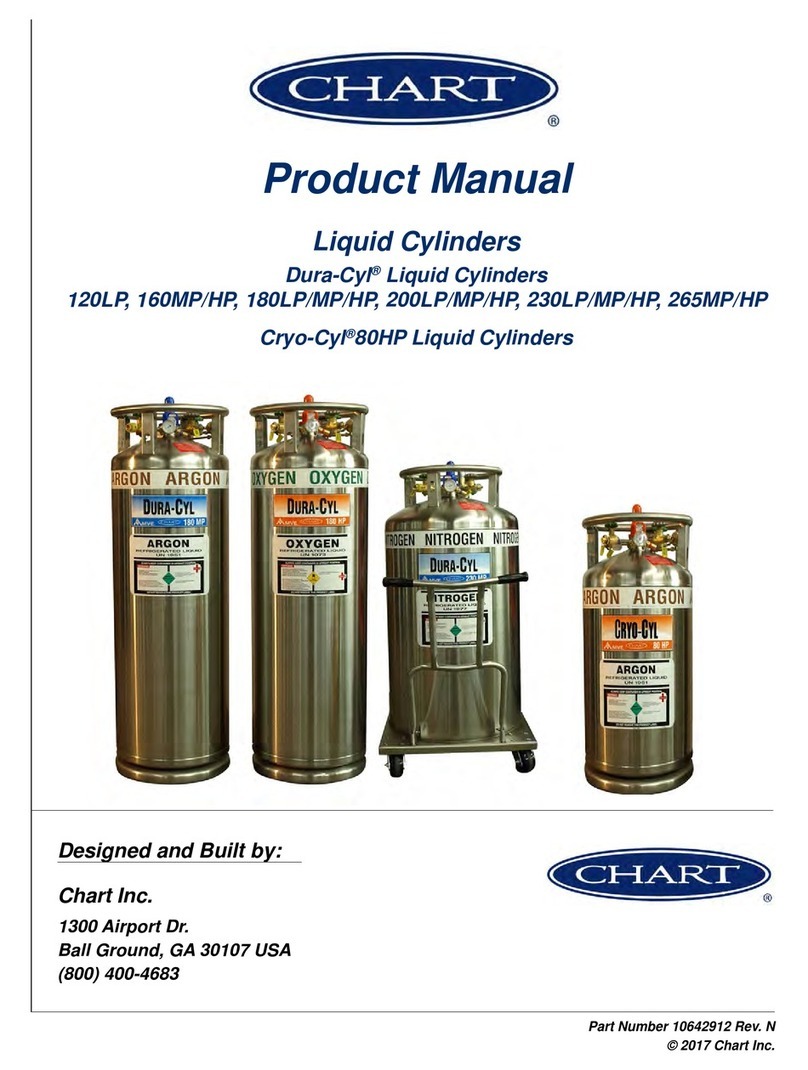
CHART
CHART Dura-Cyl 120LP User manual
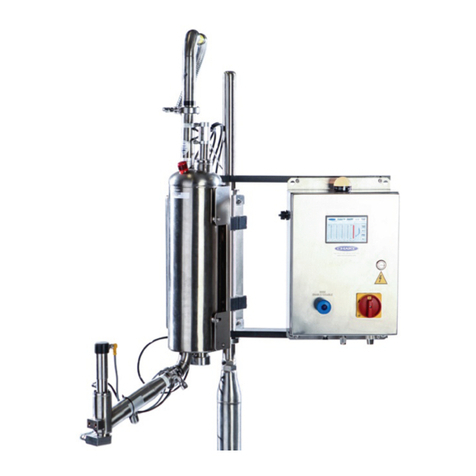
CHART
CHART CryoDoser FleX User manual
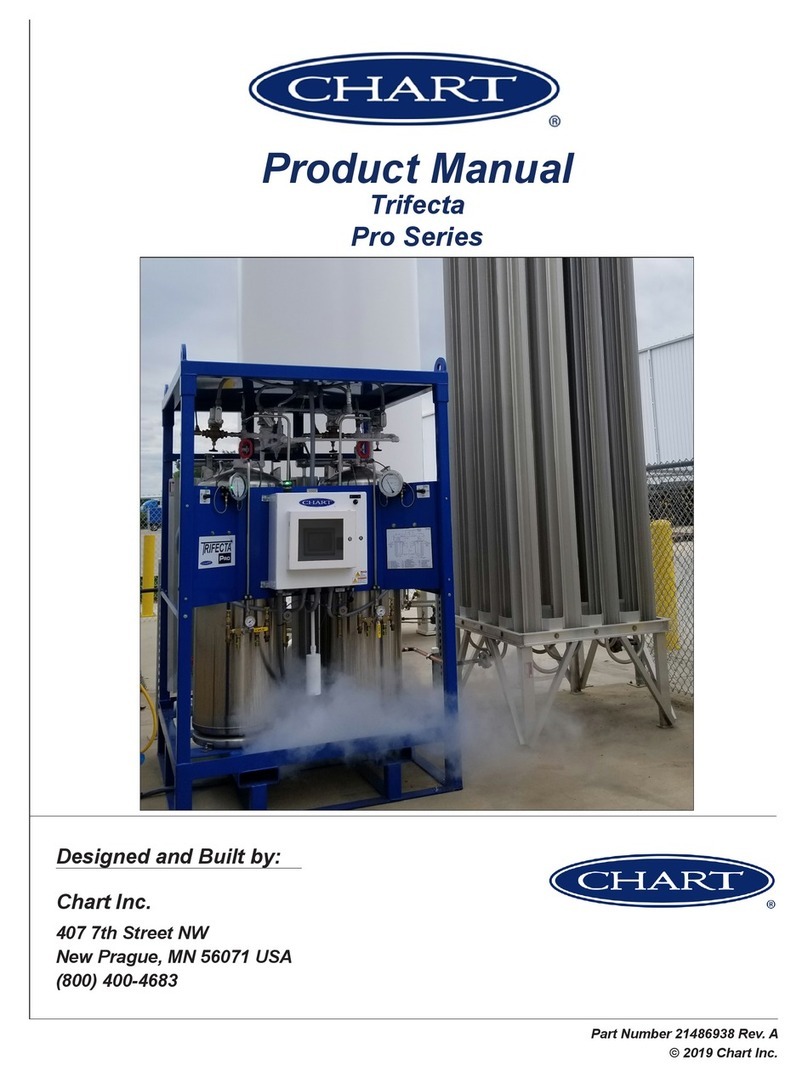
CHART
CHART Trifecta Pro Series User manual
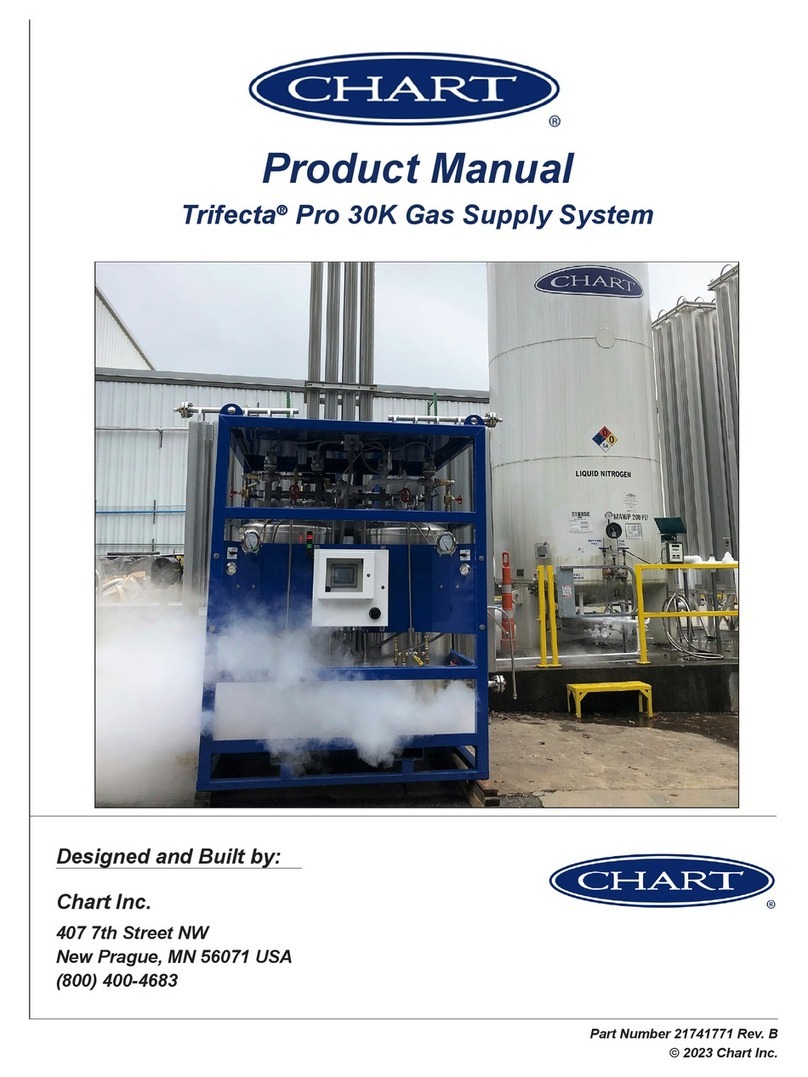
CHART
CHART Trifecta Pro 30K User manual
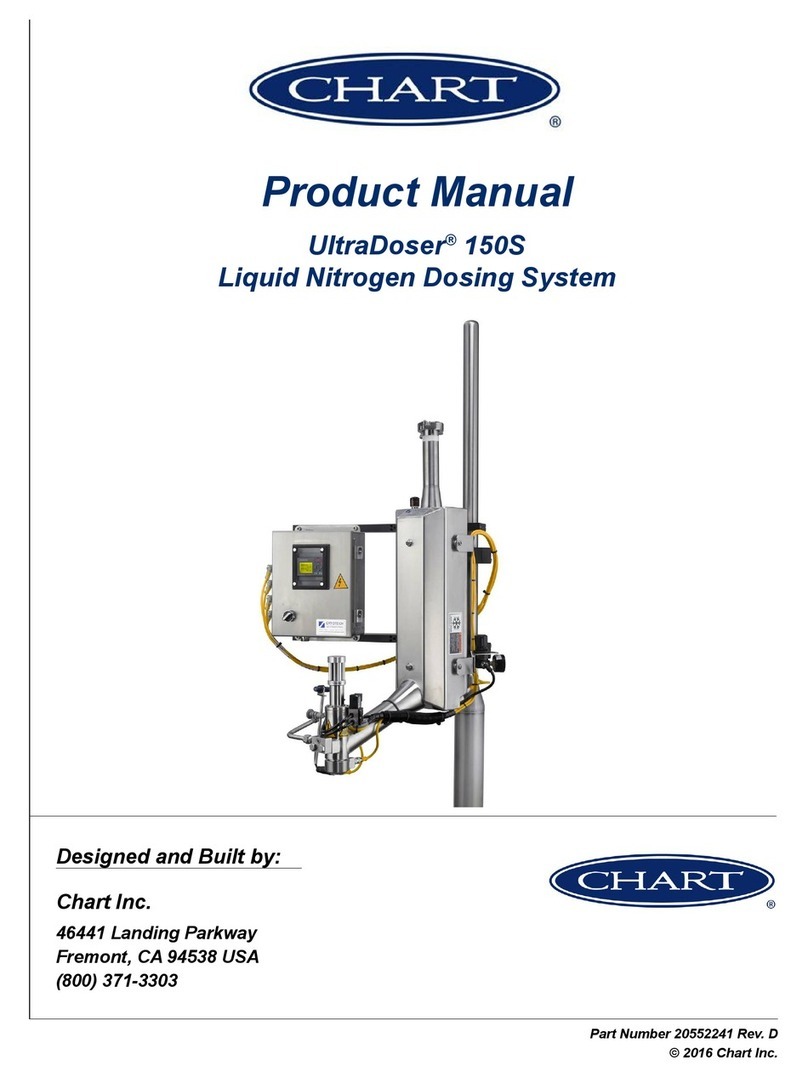
CHART
CHART UltraDoser 150S User manual
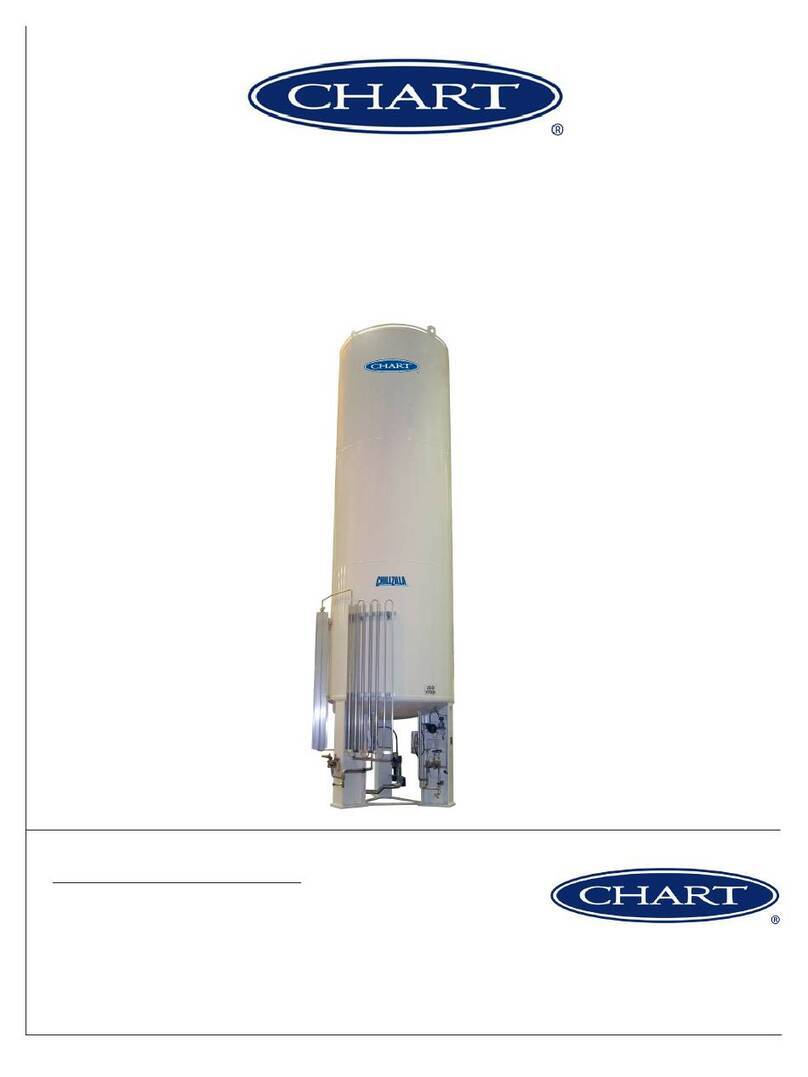
CHART
CHART ChillZilla VS-9000CZ User manual
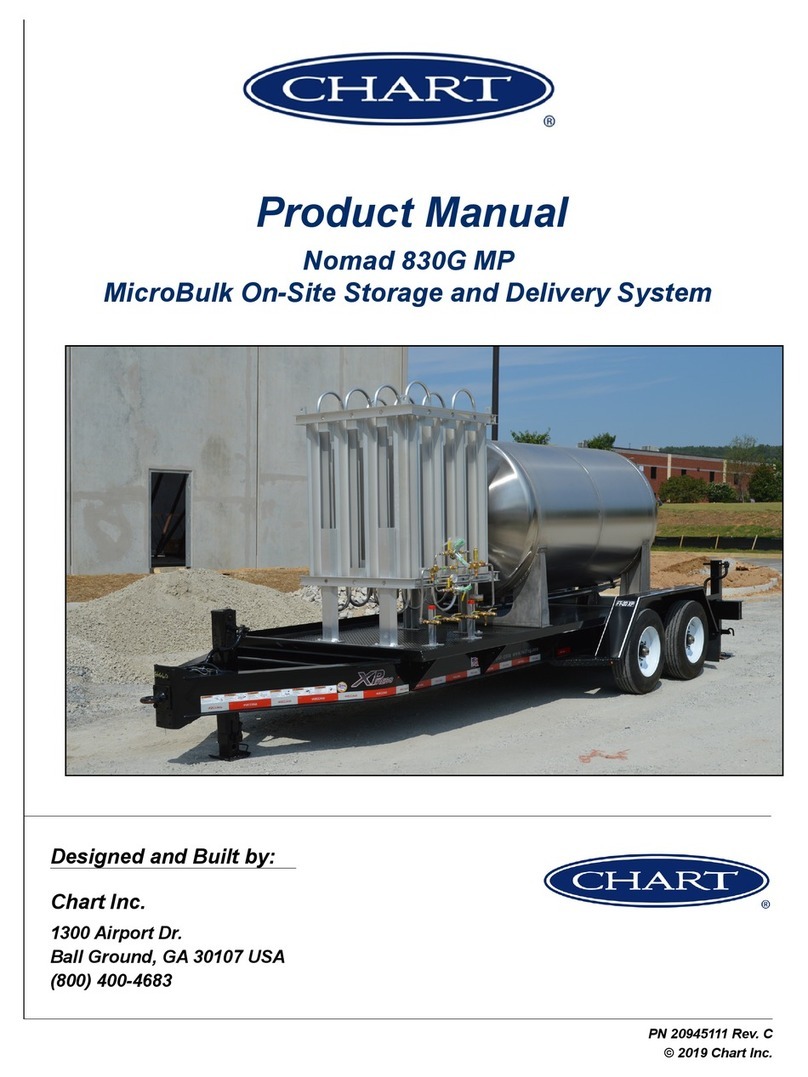
CHART
CHART Nomad 830G MP User manual

CHART
CHART ULTRADOSER 500S User manual
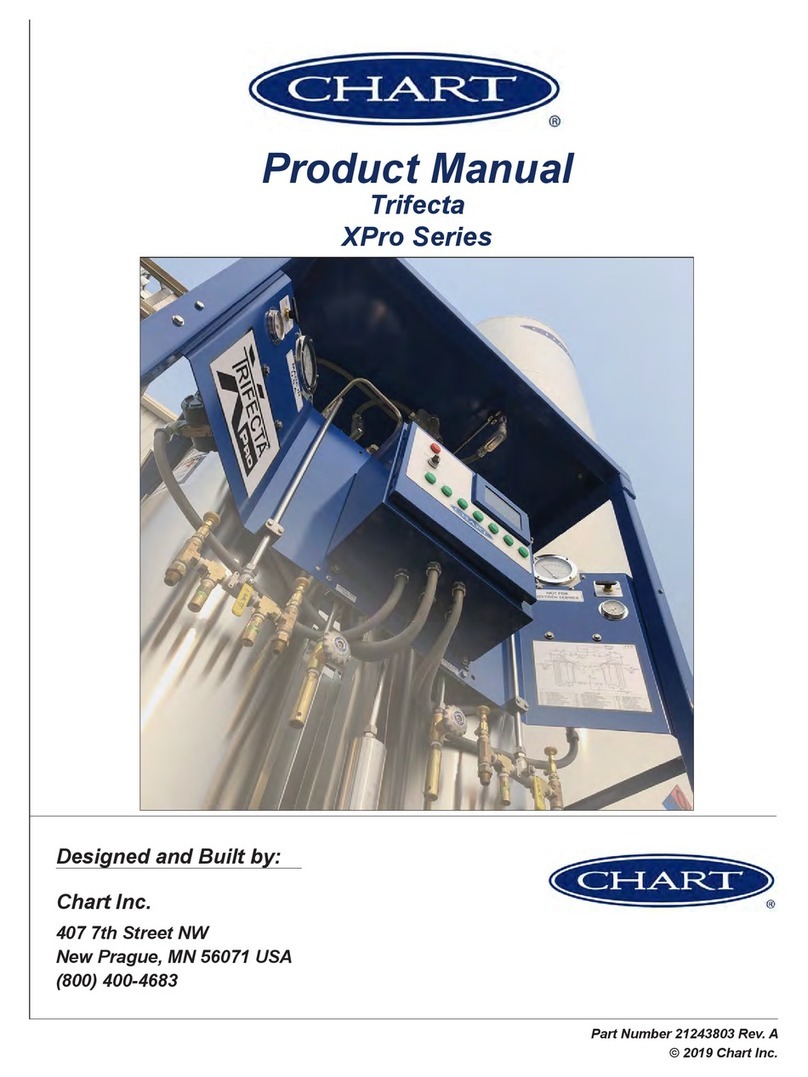
CHART
CHART Trifecta XPro Series User manual
Popular Industrial Equipment manuals by other brands

PCB Piezotronics
PCB Piezotronics ICP RHM240A03 Installation and operating manual
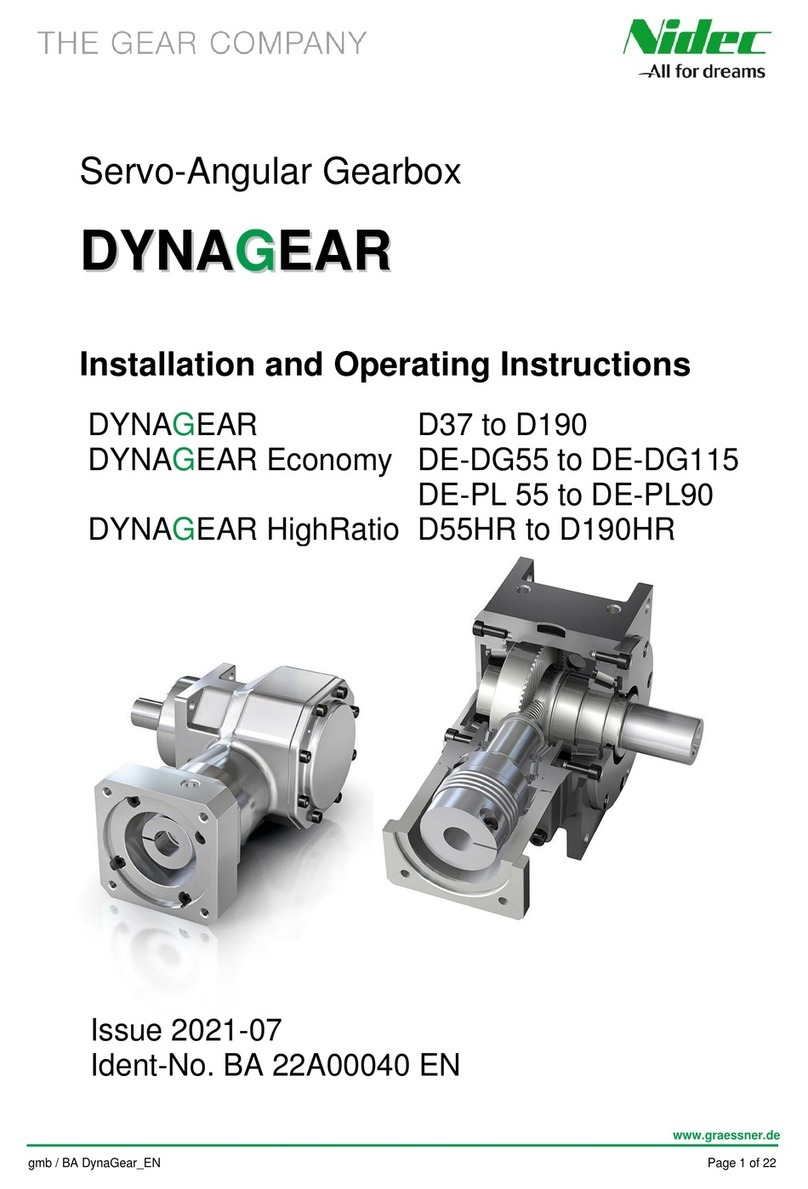
Nidec
Nidec DYNAGEAR D37 Installation and operating instructions
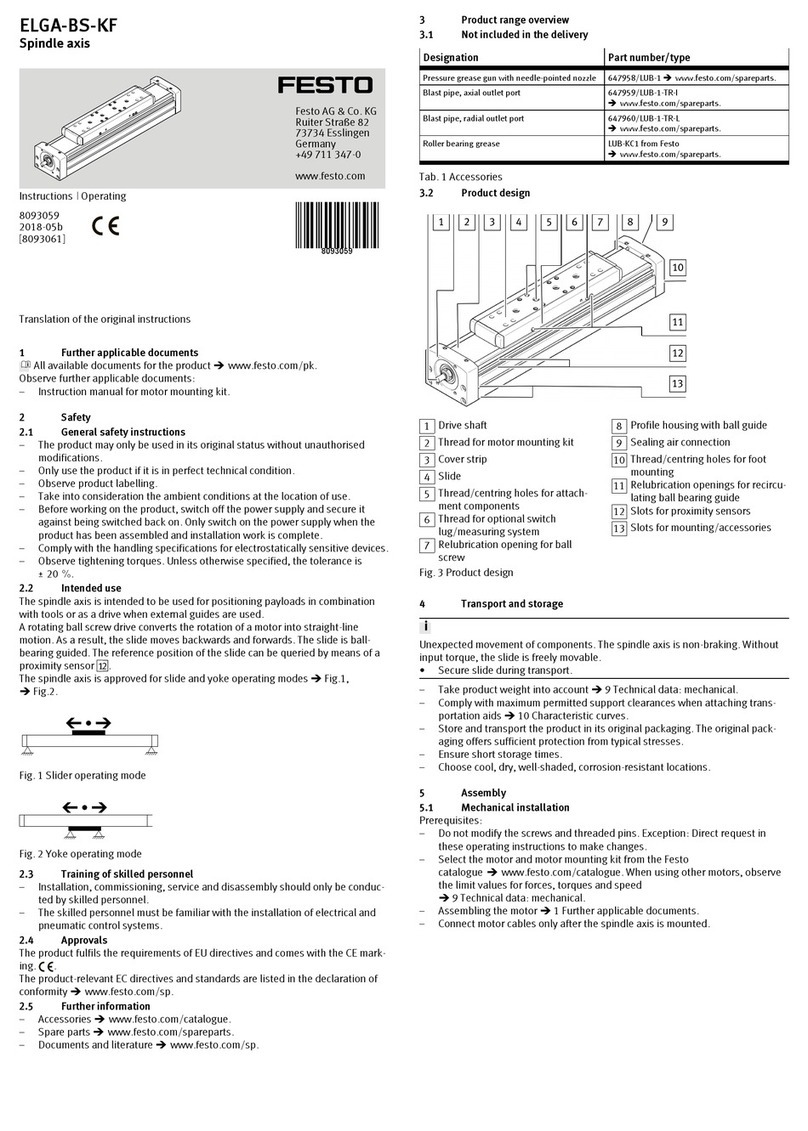
Festo
Festo ELGA-BS-KF-80 instructions
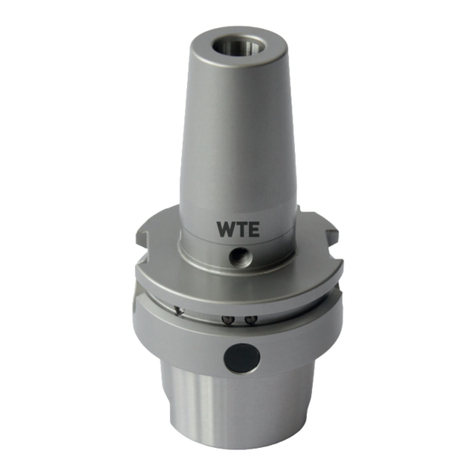
Mapal
Mapal WTE Installation and operating instructions
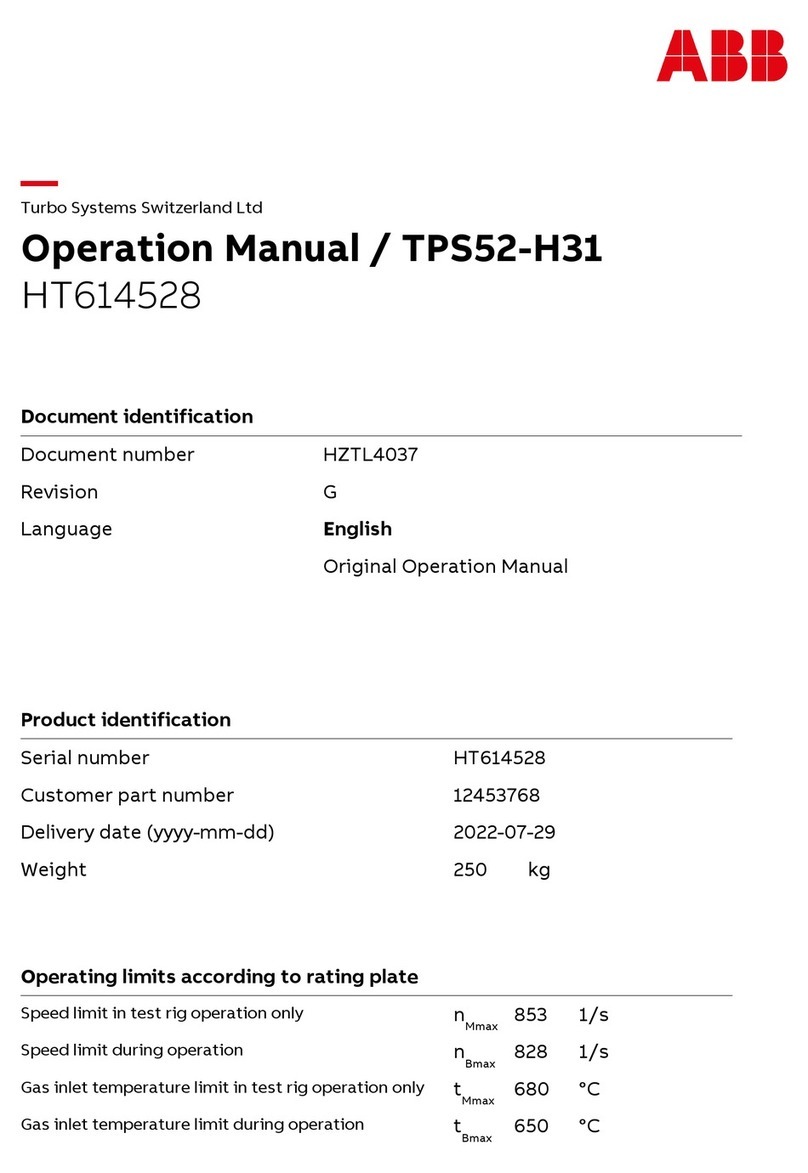
ABB
ABB HT614528 Operation manual
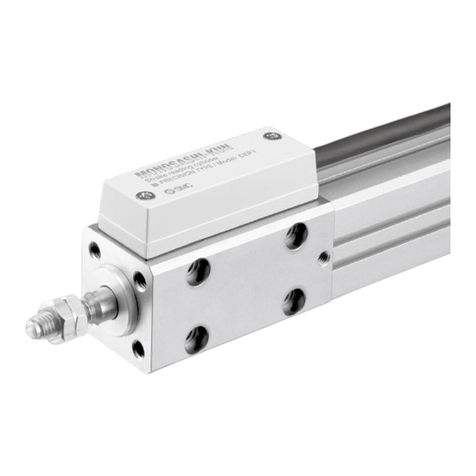
SMC Networks
SMC Networks CE Series user manual


